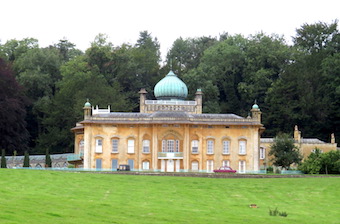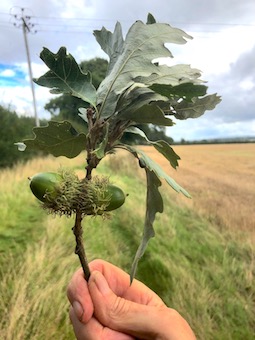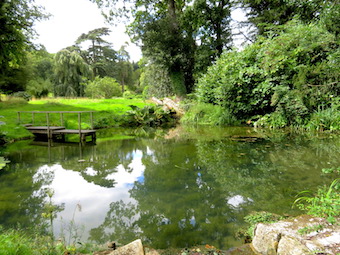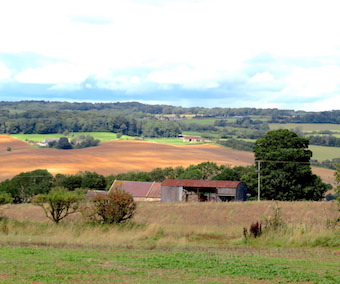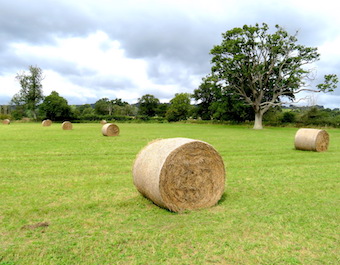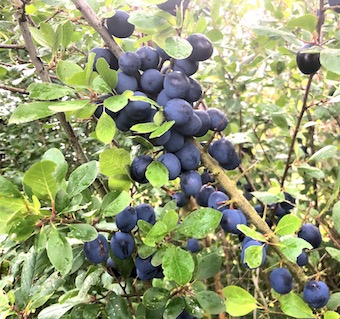First published in: The Times Click here to view a map for this walk in a new window







Facebook Link:

When Sir Henry Seymour of Marwell Hall, flushed with Protestant zeal at the Reformation, found that the priest of St Andrew’s Church at Owslebury had been saying Latin Mass, he had the man arrested. The priest escaped, returned to the church, and was shot at the altar. It didn’t pay to cross Henry Seymour – he counted King Henry VIII and Thomas Cromwell as his brothers-in-law.
Rough times at Owslebury back then; but not today, with apples ripening in the village gardens and the old houses trim under their thatched roofs. Beyond the churchyard we picked up the Monarch’s Way path, and followed it along green lanes through steeply rolling countryside of corn stubbles, cattle pasture and scattered woods.
A young roe deer was feeding on the stubble near Austin’s Copse, raising its head every few seconds to flap the flies out of its ears. At Woodlock’s Down Farm a beautiful young horse, black and glossy, galloped across his paddock, snorting with sheer joie de vivre.
The paths around pretty brick-and-flint Upham were bounded with old hedges coming into fruit for autumn – scarlet haws, shiny purple elderberries, greeny-black clusters of guilder rose berries, and quadripartite spindle berries beginning to pink up.
Turning west, we crossed a field where Jane spotted an unnaturally regular shape among the stones. It was a flint scraper, four inches long, its edges scalloped, its business end chipped to a blade-shape, an artful hollow in one side in which the thumb fell precisely where its pressure could be best applied. A tool still fit for purpose after lying in the earth for who knows how long. Ten thousand years? Twenty?
We crossed a Roman road, present on the map but smoothed out of existence by the ploughing of millennia. The homeward path skirted Marwell House, then headed north across the roll and dip of harvest fields and horse paddocks towards Owslebury, where the rooks were beginning to gather for their evening rituals.
Start: Ship Inn, Owslebury, Hants SO21 1LT (OS ref SU 511233)
Getting there: Bus 63 from Winchester
Road – Owslebury is signed from B2177 (Bishop’s Waltham-Winchester), 1 mile from Fisher’s Pond on B3354.
Walk (7 miles, easy, OS Explorer 132): From Ship Inn, left along road (‘Petersfield’). In 300m, right through churchyard; right (515234, fingerpost/FP) along lane (‘Monarch’s Way’/MW). In 400m, through barrier (517230); left along track for ½ mile to cross Lower Baybridge Lane (521226). Up Phillips Farmhouse drive; in 350m, left at deer gate (521222) along edge of Austin’s Copse.
In 350m, left along Greenhill Lane track (524221). In 400m, right (529223, yellow arrow/YA, ‘Footpath Only’) along hedge. Follow YAs and FPs for ½ mile to pass Woodlock’s Down Farm (533217). In 100m, left (532216, 3-finger FP); follow FPs and YAs to road at White Hill (538209). Right into Upham; in 200m, left at grass triangle to pass Brushmakers Arms PH (540206). Right at phone box. Past church, right (538206, ‘Owslebury’); in 100m, left (‘MW’, FP).
Follow MW for 1¼ miles to cross Red Lane (521214). Ahead (YA) through neck of Sladford’s Copse. Along field edge with hedge on left. In 400m, left through hedge gap (517214, YA); right with hedge on right; in 100m, right (stile, YA). Follow fence on right (stiles, YAs). In 150m, right through gates (515214); over stiles then right (513214, stile, YA) up fenced path to Whaddon Lane (512216).
Right; in 200m, right (512217) up Lower Baybridge Lane. In 550m left (517220, wicket gate, FP) up 2 fields with hedge on left; down to cross valley to stile (514228) and fenced path to Owslebury.
Lunch: Ship Inn, Owslebury (01962-777756, owslebury.org.uk); Brushmakers Arms, Upham (01489-860231, thebrushmakersarms.com) – booking advisable at both
Accommodation: Crown Inn, Bishop’s Waltham SO32 1AF (01489-893350, crowninnbishopswaltham.co.uk)
Info: Winchester TIC (01962-840500)
satmap.com; ramblers.org.uk
























